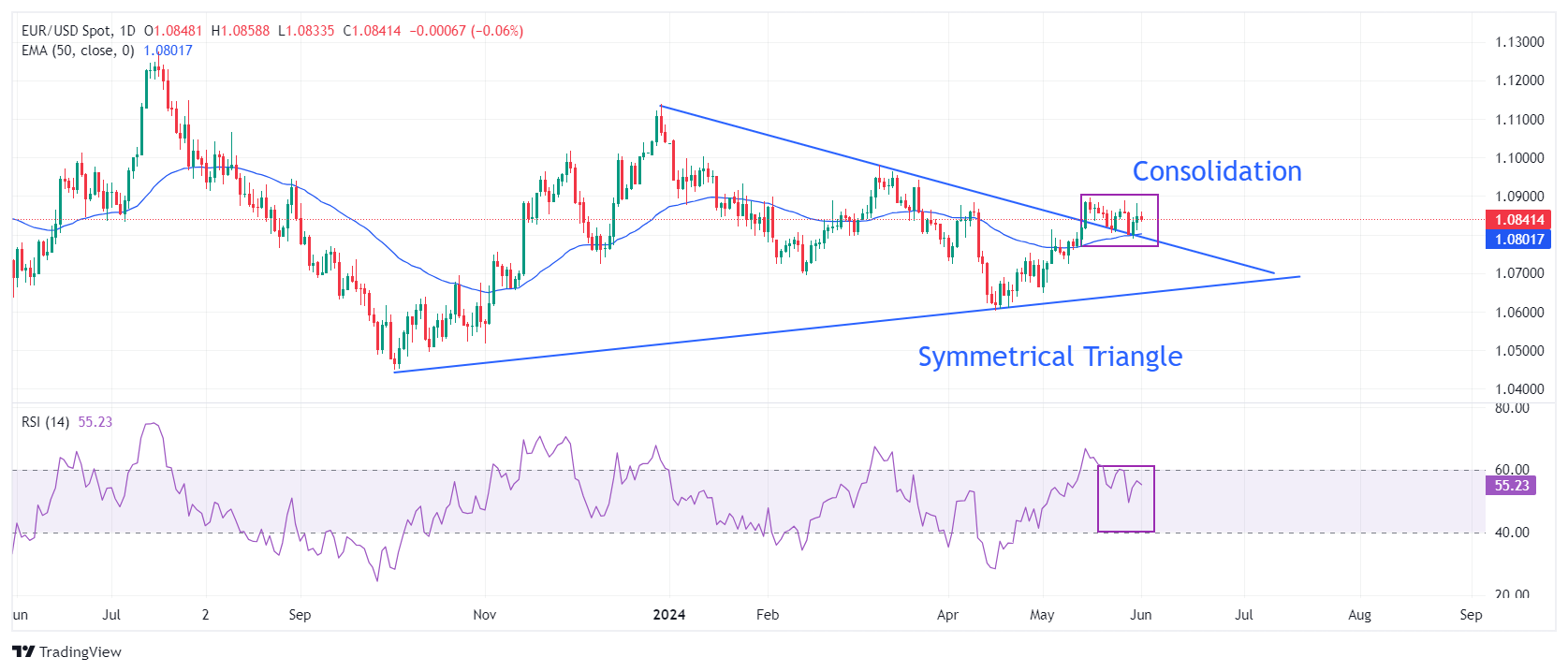EUR/USD trades cautiously amid caution ahead of ECB’s policy decision, US data-packed week

- EUR/USD faces pressure above 1.0850 ahead of key US economic events and the ECB’s monetary policy decision.
- The ECB is widely anticipated to announce interest rate cuts on Thursday.
- The US NFP will provide fresh cues about Fed rate-cut timing on Friday.
EUR/USD struggles to sustain above 1.0850 in Monday’s New York session. The major currency pair faces pressure as the revised HCOB Manufacturing Purchasing Managers Index (PMI) showed that factory data dropped slightly to 47.3 from the consensus and the preliminary reading of 47.4.
This week, the shared currency pair is expected to remain volatile as investors shift focus to the European Central Bank’s (ECB) interest rate decision, which will be announced on Thursday.
Financial markets anticipate the ECB will cut its key Main Refinancing Operations Rate by 25 basis points (bps) to 4.25%. Therefore, market participants remain more interested in cues for the rate-cut path beyond the June meeting.
Expectations for the ECB to deliver subsequent rate cuts in the July meeting have waned after the Eurozone’s preliminary Harmonized Index of Consumer Prices (HICP) report for May showed that the journey towards achieving the 2% inflation is expected to remain bumpy.
Eurostat reported on Friday that the annual preliminary Eurozone HICP grew at a faster pace than expected in May. Headline HICP rose by 2.6%, stronger than the estimates of 2.5% and April’s reading of 2.4%. In the same period, the core HICP data – which excludes volatile components such as food, energy, alcohol and tobacco – accelerated to 2.9%, from expectations of 2.8% and the prior reading of 2.7%.
Daily digest market movers: EUR/USD slips below 1.0850 as Eurozone PMI misses estimates
- EUR/USD struggles for firm footing amid caution ahead of the ECB’s interest rate decision and the United States Nonfarm Payrolls (NFP) report for May, which will be released on Thursday and Friday, respectively. The labor market data will provide fresh cues about when the Federal Reserve (Fed) could start reducing interest rates.
- The CME FedWatch tool shows that the probability of a rate cut by the Fed in the September meeting has increased to 52% from 49% recorded a week ago. Market speculation for the Fed reducing interest rates in September improved after the Personal Consumption Expenditures Price Index (PCE) report showed on Friday that the Personal Spending growth momentum slowed to 0.2% in April from the estimates of 0.3% and the prior reading of 0.7%. However, the core PCE inflation, the Fed’s preferred inflation gauge, rose expectedly by 2.8% on a year-over-year basis.
- Meanwhile, the US Dollar Index (DXY), which tracks the Greenback’s value against six major currencies, remains subdued near 104.70. In Monday’s session, investors will focus on the US Institute for Supply Management (ISM) Manufacturing PMI data for May, which will be published at 14:00 GMT.
- The ISM Manufacturing PMI is estimated to have risen to 49.8 from 49.2. However, a figure below the 50.0 threshold is considered a contraction in the sector. Investors will also focus on other sub-components, such as New Orders and Prices Paid indexes, which are leading inflation indicators.
Technical Analysis: EUR/USD dips below 1.0850
EUR/USD drops to 1.0835 after failing to hold strength above the crucial support of 1.0850. The major currency pair has been consolidating in a tight range of 1.0788-1.0900 in the last three weeks, suggesting a sharp volatility contraction. The asset holds the breakout move of the Symmetrical Triangle chart formation on a daily timeframe, indicating the upside bias is still intact.
The near-term outlook remains firm as the 50-day Exponential Moving Average (EMA) near 1.0800 is sloping higher.
The 14-period Relative Strength Index (RSI) has slipped into the 40.00-60.00 range, suggesting that the momentum, which was leaned toward the upside, has faded for now.
The major currency pair would strengthen if it recaptures a two-month high around 1.0900. A decisive break above this level would drive the asset towards the March 21 high, around 1.0950, and the psychological resistance of 1.1000. However, a downside move below the 200-day EMA at 1.0800 could push it further down.
Economic Indicator
Nonfarm Payrolls
The Nonfarm Payrolls release presents the number of new jobs created in the US during the previous month in all non-agricultural businesses; it is released by the US Bureau of Labor Statistics (BLS). The monthly changes in payrolls can be extremely volatile. The number is also subject to strong reviews, which can also trigger volatility in the Forex board. Generally speaking, a high reading is seen as bullish for the US Dollar (USD), while a low reading is seen as bearish, although previous months’ reviews and the Unemployment Rate are as relevant as the headline figure. The market’s reaction, therefore, depends on how the market assesses all the data contained in the BLS report as a whole.
